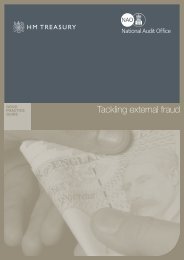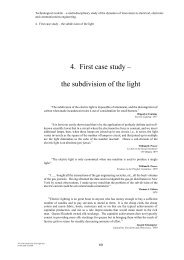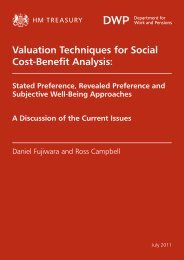Valuing Our Natural Environment Final Report ... - HM Treasury
Valuing Our Natural Environment Final Report ... - HM Treasury
Valuing Our Natural Environment Final Report ... - HM Treasury
Create successful ePaper yourself
Turn your PDF publications into a flip-book with our unique Google optimized e-Paper software.
<strong>Valuing</strong> <strong>Our</strong> <strong>Natural</strong> <strong>Environment</strong> – <strong>Final</strong> <strong>Report</strong> - Annex1<br />
approaches. However, it would appear that is necessary to trade-off this ‘real’ market data<br />
with data from hypothetical markets in order to account for non-use values, which can form<br />
a substantial proportion of total economic value and provide justification for preservation<br />
of the natural environment. Much emphasis should also be placed on ensuring that practical<br />
application of the CVM are guided by current best practice, particularly since the method is<br />
a focal point for much discussion concerning the measurement of individual’s preferences.<br />
This may imply that the approach is relatively expensive to undertake, although the cost of<br />
undertaking a CVM study should be viewed in comparison to the actions which are the<br />
concern of the decision-making context.<br />
A1.1.6.14 Conflicts and synergies with other methods<br />
The CVM is flexible. For instance, one-to-one in-depth interviews, focus groups and<br />
workshops could be used to investigate methodological issues such as consumer versus<br />
citizen preferences. CVM studies may also be carried out in conjunction with travel cost<br />
studies or avertive expenditure studies since data necessary for these studies could be<br />
collected through a CVM questionnaire.<br />
A1.1.7 Choice Modelling<br />
A1.1.7.1 Objectives<br />
The term choice modelling covers a set of stated preference techniques which, via the use<br />
of surveys, elicit respondent’s values for environmental goods and services by asking them<br />
to choose between different scenarios characterised by different levels of environmental<br />
attributes and different associated costs.<br />
A1.1.7.2 Value concept encapsulated<br />
Depending on survey design, both direct and non-direct use elements of total economic<br />
value may be estimated. Note however, that not all choice modelling approaches yield<br />
estimates of value consistent with economic theory (see below).<br />
A1.1.7.3 Theoretical basis<br />
Choice modelling approaches are based around the notion that any good can be describe in<br />
terms of it characteristics (or ‘attributes’) and the levels that these characteristics take.<br />
For example, a lake may be described in terms of its ecological quality, chemical water<br />
quality of appearance. Likewise, woodland can be described in terms of its species<br />
diversity, age and recreational facilities. The following briefly summarises the different<br />
choice modelling approaches (see Bateman et al., 2002):<br />
• Choice experiments – in this approach respondents are presented with a series of<br />
alternatives and are asked to choose their most preferred. In order for estimates of<br />
economic value to be derived, a baseline option corresponding to the status quo or a<br />
‘do nothing’ option is included in the choice set presented to respondents. With choice<br />
experiments, respondents are required to trade-off changes in attribute level against<br />
the cost of these changes. In addition, though, the baseline option implies that<br />
respondents can opt for the status quo at no additional cost. Data from choice<br />
experiments is typically analysed by econometric techniques based on the theory of<br />
rational probabilistic choice, enabling estimates of willingness to pay to be derived for<br />
different attributes of environmental goods and services.<br />
• Contingent ranking – in this approach respondents are required to rank a set of<br />
alternative options. Each alternative option is characterised by a number of attributes<br />
which vary in level across different options. In order for results from contingent ranking<br />
exercises to be consistent with economic theory, one of the options presented to<br />
respondents must represent the status quo. If the status quo is not included, then<br />
respondents are effectively ‘forced’ to choose one of the alternative options (neither of<br />
which they may actually prefer).<br />
eftec A22<br />
December 2006





![AIRTO [Professor Dr Brian Blunden] - HM Treasury](https://img.yumpu.com/15492848/1/184x260/airto-professor-dr-brian-blunden-hm-treasury.jpg?quality=85)










